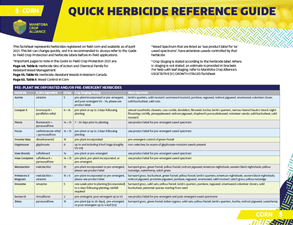Growth Stage and Herbicide Application

Herbicide applications are well-underway in corn, including tank-mixes. Fields should always be scouted before any herbicide application for weeds present, precise crop staging and environmental conditions that could have an affect on efficacy.
Applying a herbicide at early growth stages provides greater crop safety, in most cases. The corn plant has a smaller surface area to be in contact with the herbicide, which means a smaller risk of damage. Herbicides with active ingredients like 2,4-D or dicamba can need to be applied to the crop as early as possible for this reason: the larger the crop, the greater the plant surface area and the greater the risk to the crop. It is very important to refer to all herbicide labels and contact appropriate companies with any questions prior to applications.
Refer to Manitoba Crop Alliance’s Vegetative Growth Stage ID factsheet for staging tips.
Also available is a Quick Herbicide Reference Guide for current pre-emergent and post-emergent herbicides on the market in Manitoba.
Post-emergent herbicide application tips: (for full list, visit https://www.dekalbasgrowdeltap…)
- ALWAYS READ AND FOLLOW LABEL DIRECTIONS.
- Corn under stress may not have the ability to metabolize some herbicides quickly enough to avoid crop injury. Weeds under stress may not may not accept the herbicide to its full capacity.
- Spray additives can increase the rate of herbicide uptake by the crop.
- Herbicide residues from previous applications may remain in the spray tank causing contamination.
- Post-emergent herbicide injury symptoms can include leaf chlorosis or necrosis, onion leafing, internode stacking, rat tailing, ear pinching, ear bottlenecking, brace root malformation, and green snap.
Reference: https://www.dekalbasgrowdeltap…

